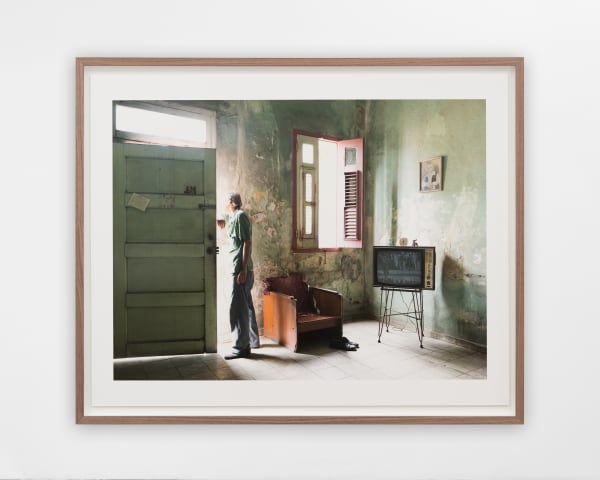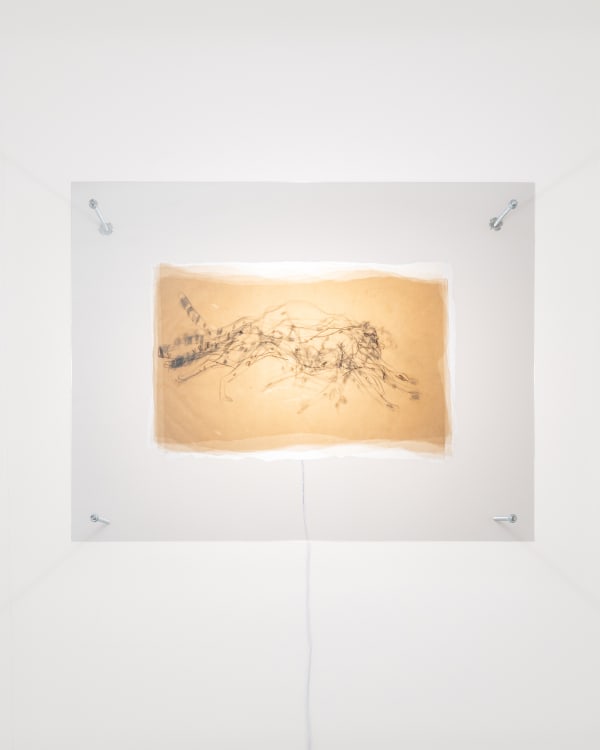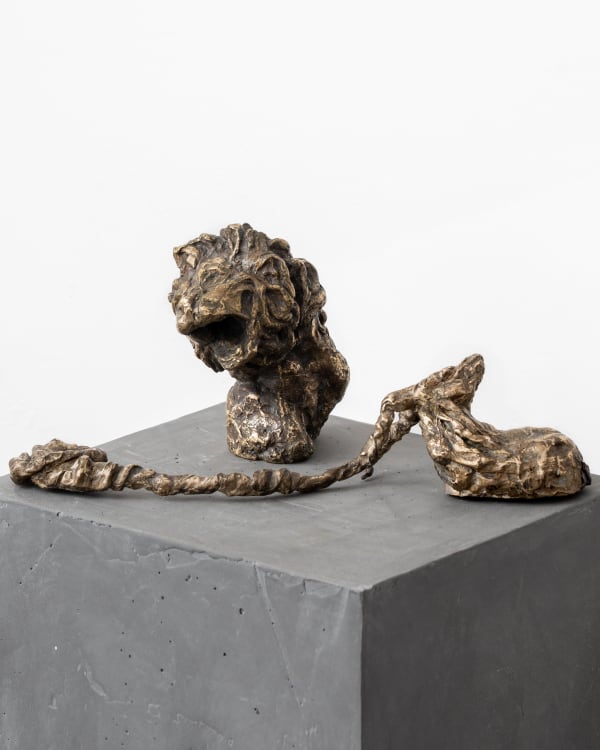Hogar Y Esperanza I Group Show
Brigade is pleased to present Hogar y esperanza, Home & Hope, an exhibition featuring eight contemporary Cuban artists. The genesis of this exhibition begins more than four years ago when Brigade first visited Havana. In this enigmatic city at the precipice of history we met a resilient and dedicated community of artists who have continued creating art under the most difficult of conditions, and it is with gratitude that we are finally able to exhibit eight of these in Copenhagen. The exhibition text below was written by Sachie Hernández Machín, a well-established Cuban art professional and the founder and director of the independent art project La Sindical in Havana.
Texto de la exposición en español/Spanish version
-
 Ernesto Garcia SánchezPolymorphous 8, 2022Acrylic paint on wood panel115 x 95.5 x 23.5 cm
Ernesto Garcia SánchezPolymorphous 8, 2022Acrylic paint on wood panel115 x 95.5 x 23.5 cm
45 1/4 x 37 1/2 x 9 1/4 in -
 Linet SánchezSin Titulo #8, 2018wood, glass, mat, vinyl and LED light35 x 35 x 15.5 cm
Linet SánchezSin Titulo #8, 2018wood, glass, mat, vinyl and LED light35 x 35 x 15.5 cm
13 3/4 x 13 3/4 x 6 in -
 Linet SánchezUntitled #8, from Untitled Series, 2013archival pigment print on Hahnemühle 320gsm69 x 99 cm / 27 1/4 x 39 in (motif)
Linet SánchezUntitled #8, from Untitled Series, 2013archival pigment print on Hahnemühle 320gsm69 x 99 cm / 27 1/4 x 39 in (motif)
76 x 106 cm / 29 x 41 3/4 in (framed)
-
 Alejandro GonzálezAny day of 1965-2012, 2012 - 2013archival pigment print on Hahnemühle 320gsm63.5 x 80 cm (Unframed)
Alejandro GonzálezAny day of 1965-2012, 2012 - 2013archival pigment print on Hahnemühle 320gsm63.5 x 80 cm (Unframed)
70.5 x 85.5 cm (Framed) -
 Alejandro GonzálezJuly 7, 1989, 2012 - 2013archival pigment print on Hahnemühle 320gsm80 x 63.5 cm (Unframed)
Alejandro GonzálezJuly 7, 1989, 2012 - 2013archival pigment print on Hahnemühle 320gsm80 x 63.5 cm (Unframed)
86 x 70.5 cm (Framed)
-
 Alejandro GonzálezNovember 9, 1989, 2012 - 2013archival pigment print on Hahnemühle 320gsmFramed in walnut veneer, 63.5 x 80 cm. (motif) 70.5 x 85.5 cm. (framed)
Alejandro GonzálezNovember 9, 1989, 2012 - 2013archival pigment print on Hahnemühle 320gsmFramed in walnut veneer, 63.5 x 80 cm. (motif) 70.5 x 85.5 cm. (framed) -
 Susana PilarResistencia, 2019Video work 00:32:48 min
Susana PilarResistencia, 2019Video work 00:32:48 min -
 Osvaldo GonzálezEl ascenso / The rise (Serie La brecha), 2022adhesive tape, plexiglass, resine, LED light71.5 x 84.5 x 10.5 cm
Osvaldo GonzálezEl ascenso / The rise (Serie La brecha), 2022adhesive tape, plexiglass, resine, LED light71.5 x 84.5 x 10.5 cm
28 1/4 x 33 1/4 x 4 1/4 in -
 Osvaldo GonzálezSarmiento de Bengoa, 2022adhesive tape, plexiglass, resine, LED light84 x 130 x 10.5 cm
Osvaldo GonzálezSarmiento de Bengoa, 2022adhesive tape, plexiglass, resine, LED light84 x 130 x 10.5 cm
33 x 51 1/4 x 4 1/4 in
(variable 10 cell of 25 x 25 cm / 9 3/4 x 9 3/4 in) -
 Mari Claudia GarcíaLiberty is a Palimpsest, 2021video work 00:09:50 min
Mari Claudia GarcíaLiberty is a Palimpsest, 2021video work 00:09:50 min -
 Arles del Rio7,817,382,066, 2020-2022(from the series 'Nosotros')
Arles del Rio7,817,382,066, 2020-2022(from the series 'Nosotros')
sandblast etching on mirror glass
80 x 60 cm
31 1/2 x 23 1/2 in -
 Arles del Rio7,860,141,635, 2020-2022(from the series 'Nosotros')
Arles del Rio7,860,141,635, 2020-2022(from the series 'Nosotros')
sandblast etching on mirror glass
80 x 60 cm
31 1/2 x 23 1/2 in -
 Yaily Martínez00:00:11, 2022graphite on onion paper, LED lights, acrylic sheets48 x 63 cm
Yaily Martínez00:00:11, 2022graphite on onion paper, LED lights, acrylic sheets48 x 63 cm
19 x 24 3/4 in -
 Yaily Martínez00:00:45, 2022graphite on onion paper, LED lights, acrylic sheets48 x 63 cm
Yaily Martínez00:00:45, 2022graphite on onion paper, LED lights, acrylic sheets48 x 63 cm
19 x 24 3/4 in -
 Yaily Martínez00:00:70, 2022graphite on onion paper, LED lights, acrylic sheets48 x 63 cm
Yaily Martínez00:00:70, 2022graphite on onion paper, LED lights, acrylic sheets48 x 63 cm
19 x 24 3/4 in -
 Yaily Martínez00:00:83, 2022graphite on onion paper, LED lights, acrylic sheets48 x 63 cm
Yaily Martínez00:00:83, 2022graphite on onion paper, LED lights, acrylic sheets48 x 63 cm
19 x 24 3/4 in -
 Yaily Martínez00:00:99, 2022graphite on onion paper, LED lights, acrylic sheets48 x 63 cm
Yaily Martínez00:00:99, 2022graphite on onion paper, LED lights, acrylic sheets48 x 63 cm
19 x 24 3/4 in -
 Yaily MartínezHunter (I am not Hunter) , 2022cast bronze sculpture50 x 30 x 20 cm
Yaily MartínezHunter (I am not Hunter) , 2022cast bronze sculpture50 x 30 x 20 cm
19 3/4 x 11 3/4 x 7 3/4 in



























